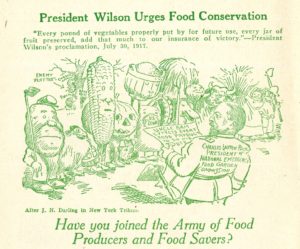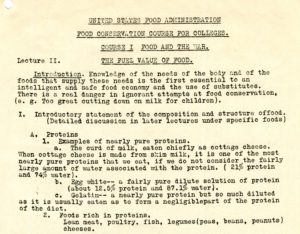Today I am continuing to highlight some of the new resources available online that highlight the Northfield experience during World War I. In the last post, I shared some aerial photographs from France kept in a scrapbook by Irwin Smith, who served in the Intelligence Division “over there” during the war.
Closer to home, the households of the Northfield area were also heavily involved in wartime activities. Since Rice County is a very agricultural area, many local citizens were encouraged to contribute to the production and conservation of food for local and worldwide consumption. The National Emergency Food Garden Commission was formed shortly after America entered the war to promote food conservation ideas as well as educate Americans on how to participate. The commission urged households to grow and produce their own food so that the food they would normally buy could be exported to feed American troops and the populations of the Allied Nations.

Cartoon of produce joining the Army of Food Producers and Food Savers, 1917, from the Manual for Home Storage, Pickling, Fermentation and Salting Vegetables
This cartoon was printed in a manual with guidelines for the home storage, pickling, fermentation, and salting of perishable vegetables and fruits in 1917. Rice County Historical Society owns many of these wartime food conservation guides, with practical information on preserving produce, preparing dishes using new types of flour rather than wheat, and following recipes for sugarless sweets. Local families and businesses followed wheatless and meatless days. Even candy stores bought into the idea of using less sugar and created sweets based on fruit, nuts, and even the newly popular peanut butter. The idea was that the soldiers needed the meat and the wheat and the sugar more than the folks at home. Some of the recipes are also due to wartime shortages and issues with the food supply lines.
“Are we to do less now for sugar than we did last year for wheat?” the United States Food Administration wrote in a Sugar for the Common Table recipe booklet. “Are we not going to face the sugar shortage squarely and solve it satisfactorily?” The booklet continues:
Let it again be said to our honor, we have ungrudgingly shared with the brave soldiers and the War-wearied folks of other lands who sit with us now at freedom’s common table. When we eat candy, we must eat war confections. The old-fashioned candies, made largely from sugar, should be discouraged. On the succeeding pages are suggestions for making war confections. Patriotic people, big and little, will use these instead of pre-war candies.

Recipes from the manual Sugar for the Common Table, October 1918
Through food preservation and sacrificing pre-war sweets, meats, and wheats, people at home in Northfield could show their patriotic support for the war effort.
Another interesting facet of the food conservation movement during the war was the growth in understanding of nutritional science. The United States Food Administration developed a college course called “Food and the War” which was designed to provide students information not only on the wartime food situation, but also an understanding of how food fuels bodies, what calories are, different sources of protein, and more. Students at both St. Olaf and Carleton Colleges took this course, and its outline is available online.

Excerpt from Lecture II of the Food and the War course outline, 1918
By taking this course, students left behind at both colleges could learn how best to go about conserving food and other resources so that the rest of the country could focus on winning the war.
Check out the next post for more details on community organizations during and after the war!
View all of the items digitized for this project here.
